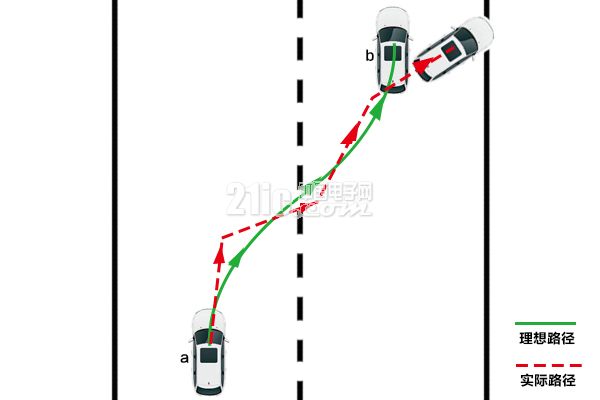Automated driving vehicles rely on artificial intelligence, visual computing, radar, surveillance devices and global positioning systems to work together, allowing computers to operate motor vehicles automatically and safely without any human active operation.
This article refers to the address: http://
Autopilot is divided into three parts: perceptual positioning, planning decision, and execution control. However, at present, the part of automatic driving related to executive control has been talked very little. This part is in the hands of Tier1 and the OEM. Because of the weak domestic accumulation, it has become a topic of avoidance. However, the executive control layer is the basis for the automatic landing of the automatic driving, and the planning decision can not be separated from the executive control. Today, this article, I will talk about the "legs and feet" problem of autonomous driving.

Can't talk about "brains" from "two feet"
To make good planning decisions for autonomous driving, you must know how to implement control.
In simple terms, the path planning of autonomous driving can be divided into global path planning and partial path planning. The global path planning is to design a route for the vehicle to pass safely from point A to point B. The partial path planning refers to planning a collision-free path according to the environmental information of a certain distance and the state of the vehicle itself. The former is like entering the starting point and the ending point on the map to generate a feasible route. The latter mainly includes the movement of the vehicle in the case of turning, lane change, overtaking, encountering construction, etc., and the relationship between this part and the execution control is closely related.
To illustrate how the "brains" and "two feet" interact, here is a fictional case - in the case of unmistakable perception, an autonomous car originally wanted to change lanes, why did you get to the road? ?
In the local path planning, the self-driving car comprehensively considers a series of constraints such as the external environment and vehicle condition at that time, simulates the old driver to drive safely, and gives an ideal partial path - small angle cut-in to realize the lane change, and will command Communicate to relevant executive agencies.
At this time, the ideal and reality have deviated.

Fictional an autopilot traffic accident, but very common
From point a to point b, the ideal local path plan requires a value of N for the vehicle's corner. However, the actuator cannot reach the value of N, resulting in deviation from the ideal path and actually exiting the dotted line.
After the car found the trajectory deviation, it began to correct, so it began to repeat the over-steering or understeer that occurred above, and finally kissed the road tooth during the winding process. If you are sitting in the car at this time, you will find that the steering wheel violently oscillates back and forth, and the ride experience must not be very pleasant.
It is not difficult to find that the main cause of the above accident is that the planning decision does not take good consideration of the vehicle dynamics factor, and the steering characteristics are underestimated, resulting in a large deviation between the actual driving trajectory of the vehicle and the planned local path. Also in the power output torque control and braking torque control, if the model data is missing or not optimized, it will cause the vehicle to feel frustrated, resulting in the vehicle not being able to brake or the throttle can not keep up, even in extreme scenes, it is extremely dangerous.
Another reason may be the lack of openness of the underlying implementation protocol. At present, Tier1 executive control products will be made into a black box, and the control protocol is paid for disclosure. Even if it is open, the degree of openness of the interface directly affects the adjustable degree of vehicle control.
Therefore, autopilot planning decisions are not a brain plan. It takes a lot of effort to control the execution of an autonomous car. From the lane change, turning these scenes can be seen one or two.
Foreign monopoly and domestic lack
We sometimes see an external motor on the auto-driving car of some colleges, the main purpose is to achieve automation. However, this method can only give very rough control, and can not meet the vehicle dynamics control, of course, it can not talk about vehicle reliability.
The self-driving car produced by the surface vector must be electronically modified by the traditional actuator of the vehicle and upgraded to a wire-controlled execution component system with an external control protocol interface, which mainly includes three parts: the line-controlled throttle, the line-controlled steering, and the line control.
At present, the execution control part of landing automatic driving is monopolized by foreign Tier1 such as Bosch and China. These Tier1s have a self-contained complete chassis control system and are mostly not open. For example, Bosch developed Ibooster, Hitachi developed EACT, the mainland developed MK C1, and Trina developed IBC.
This part of the technology is weak in domestic base, and the core parts and components that can be replaced are scarce. According to the data, domestic line control, such as Asia-Pacific shares, Wanxiang Qianchao, Wanan Technology and other manufacturers are still in the initial stage of research and development. In terms of EPS, Zhuzhou Yilida has a certain scale of support, and Henglong, Yubei, Zhejiang Shibao and other enterprises have turned to existing products. However, there is a big step from the assistance to the line control. If we can break through, we will wait and see.
Why is there such a big gap in the accumulation of implementation control in China?
This is the advantage of foreign parts suppliers using time accumulation. Execution control product research and development is about engineering, mainly relying on data accumulation, through continuous testing and model optimization. Liu Xingjian, chief engineer of the National Center for Technology Transfer Eastern Intelligent Vehicle Technology Transformation Center (IVTTC), told Car Yunzhu that it takes at least 10 years to optimize the calibration of the first-line engineering data, and then have a preliminary understanding of the chassis control. Foreign Tier1 in this regard. There are a large number of engineers with at least 20 years of experience in the first line, and continuous optimization iterations.
In contrast, domestic suppliers have weak technical bases, mostly production Tier1 (prone production capacity, lack of research and development capabilities), and insufficient technology accumulation. On the other hand, domestic engineers are highly mobile. They have been in the first-line positions for 10 years. Even if they are placed in a parts company, they are willing to invest 10-15 years on a project. It is almost invisible. In the case of insufficient accumulation of technologies such as EPS and ABS in the previous generation, domestic component suppliers have to step up to the line control system, and the steps that need to be crossed are even greater.
Therefore, the current attempts at autonomous driving are largely subject to foreign manufacturers.
On the one hand, relying on the accumulation of executive control, the self-driving car wants to travel smoothly and maintain comfort, depending largely on the chassis control capability. Also, whether it is a new driver or an old driver is the degree of understanding of vehicle control dynamics when the autonomous driving team makes decision-making plans.
On the other hand, parts suppliers such as Bosch and China also have their own products in the perception and decision-making part. Mastered the single-binocular camera, millimeter wave radar, laser radar and other sensor components and systems, coupled with the advantages of implementation control, and many have matured mass production, in line with the car-level requirements. Relying on years of accumulated engineering capabilities and automotive experience, foreign Tier1 is also significantly better than domestic sensory startups in terms of productization and cost control.
How do domestic autopilot teams handle execution control?
Can't we stop the research on domestic autopilots?
Obviously, domestic OEMs are not willing to accept the packaging solutions of component suppliers and force themselves back to the role of foundries. A typical phenomenon is that in the ADAS phase, the OEM still prefers to use the complete range of parts from the component suppliers. However, in the high-end automatic driving project, the OEM can be unpacked as much as possible to get rid of the overall dependence on Tier1 abroad.
At present, domestic OEMs are trying to dismantle the perceptual positioning, planning decision and execution layer of automatic driving by requiring the supplier interface to be transparent. At the same time, the OEMs are cultivating suppliers of perception, planning decision-making and execution layers, doing demo testing and demonstration applications in the early stage, and waiting for the technology to mature and partially replace.
In addition, some OEMs choose to use the platform of new energy vehicles for autopilot research. Thus bypassing the traditional engine and gearbox barrier technology, and replacing it with the core three-electric system of the electric vehicle, because the latter is relatively shorter in development cycle than the former, and the difficulty is smaller. The domestic component suppliers are more mature. .
In the entire industry chain, the team that squats the actuator modification has become one of the rings. For example, the National Center for Technology Transfer Eastern Center Intelligent Vehicle Technology Transformation Center focuses on vehicle chassis and power control. By adopting the overall replacement of the chassis electronics, the line-controlled chassis and the line-controlled power are turned on, so that the vehicle has a smooth control experience and can be perceived. And the planning and decision-making part provides a platform, and has the ability and technical solutions for the transformation of the line-controlled chassis for passenger cars, large commercial vehicles, and special-purpose vehicles. Another similar team---------------------------------------------------------------------------------------------------------------------------------------------------------------------------------------------------------------------------------------------------------------------------------------------------------------------------------------------------------------------------------------------------------------------------- , the range of indicators is connected to the actuator supplier.
The current situation is self-evident for domestic component suppliers that perform control. Faced with the disadvantages of individual component technology and price, domestic component suppliers are considering ways to cooperate and launch products as soon as possible. At present, domestic component suppliers cooperate with sensory and decision-making startups, and take the lead in opening up a vertical platform to develop a complete set of underlying platforms that can be mass-produced and sold to the OEMs in a complete supply manner. Dominant, but this also has to dispel the concerns of the OEM's systematic supply.
The challenges left to the domestic team in implementing control are great, but challenges and opportunities coexist.
At present, the demand for automatic driving in the domestic application environment is higher, and the domestic market runs faster than foreign countries. The willingness of the car factory to get rid of the monopoly of foreign parts suppliers is also very strong. The association of different parts of autonomous driving is also an indication of the importance of our cooperation. In this time of the race, it is not which company is the first to arrive, but which alliance is the first to hit the line.
800 puffs disposable vape pen are so convenient, portable, and small volume, you just need to take them
out of your pocket and take a puff, feel the cloud of smoke, and the fragrance of fruit surrounding you. It's so great.
We are China's leading manufacturer and supplier of disposable vape puff bars, 800 puff bar vape,800 puffs disposable vape,800 puffs vape kit
vape stick 800 puffs,e-cigarette 800 puffs, and e-cigarette kit, and we specialize in Disposable Vapes, e-cigarette vape pens, e-cigarette kits, etc.
800 puff bar vape,800 puffs disposable vape,800 puffs vape kit,vape pen 800 puffs,vape stick 800 puffs
Ningbo Autrends International Trade Co.,Ltd. , https://www.supermosvape.com